Table of Contents
Obstacle Course Racing (OCR) is a sport in which a competitor must overcome various physical challenges in the form of obstacles. It is a fairly recent phenomenon, but is one of the fastest growing mass participation sports in the world and includes mud and trail runs, adventure challenges and more competitive timed obstacle course races. The events vary in difficulty and distance, allowing those of all fitness abilities to give the sport a go.
The obstacles themselves vary immensely, but often include cargo net climbs, carrying heavy objects, traversing bodies of mud and water, crawling under barbed wire, and jumping through fire. Many obstacles are similar to those used in military training and are employed throughout the course to test endurance, strength, speed and, dexterity.
Obstacle course racing involves a combination of speed, strength, and endurance, and therefore training for events often includes a mixture of fitness techniques, from cardio to strength training. While running is the main component of an obstacle race, runners need to have a balance of endurance and total-body strength to allow them to navigate around the obstacle challenges. The answer: BMF training!
WHY PARTICIPATE IN AN OCR EVENT?
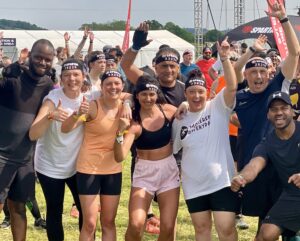
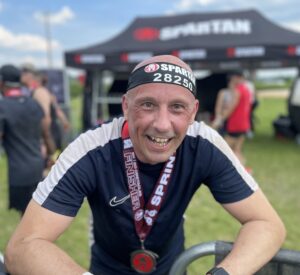
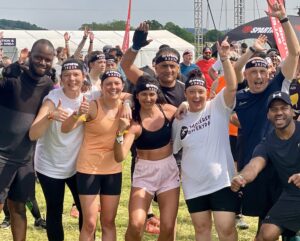
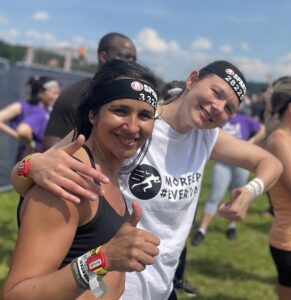
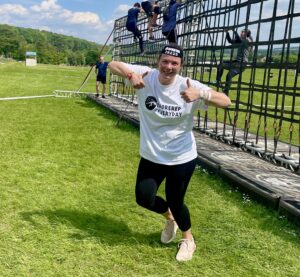
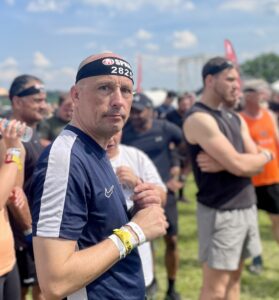
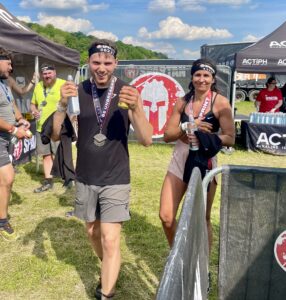
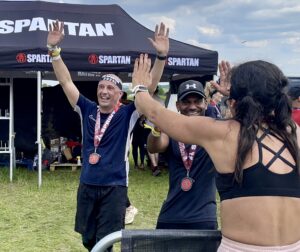
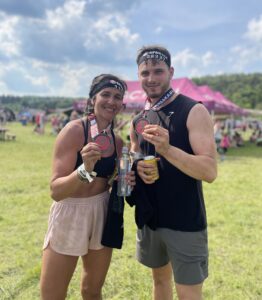
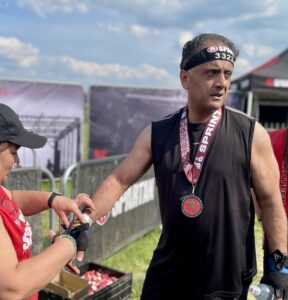
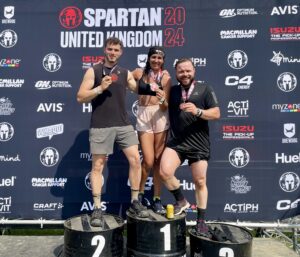
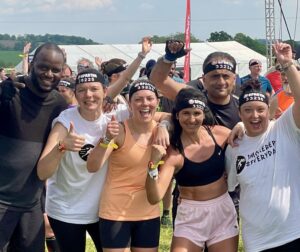
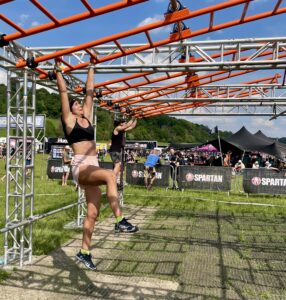
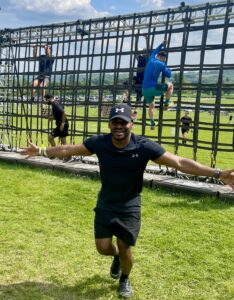
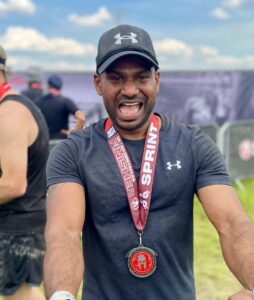

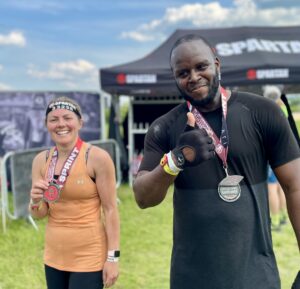
VARIETY
OCR events vary in difficulty and distance so there is something for everyone. There is a huge range of races with new and exciting obstacles so that no race is ever the same.
FOR EVERYONE
Anyone can get involved in the sport as there are OCR races catering for all fitness abilities.
CHALLENGE
OCR races require a combination of cardio and full-body power, ensuring it is a great challenge for the body involving speed, strength and endurance.
COMMUNITY
There is a very friendly welcoming community around these events, with many people forming teams and participating in events together.
OUTDOORS
OCR races are a great way of experiencing the best the outdoors has to offer. Not only that, but outdoor exercise also reduces anxiety and depression and enhances mood.
HOW TO MENTALLY TRAIN FOR AN OCR
Here are our top tips to prepare yourself for the big day!
COLD SHOWERS
While the weather in UK can be quite warm at times, somehow the water seems to always remains cold!! Water is quite common in OCR and the Major Series even has an entire “marine zone”. Cold showers are a really good way to get physically and mentally prepared for the water sections. Plus, it’s a cheaper and more efficient way to wak up in the morning than coffee!
BE READY TO BE UNCOMFORTABLE
The nature of the event means you may get cold, you’ll definitely get covered in mud and you’ll hopefully have plenty of obstacles too! The mix of these elements means it’s quite likely that at some point in your next OCR you may feel uncomfortable. Be ready!
PICTURE YOURSELF CROSSING THE FINISH LINE
Think of how good it will feel to succeed. What will it mean to you, your family, your friends? Think of that during your training and during the race, and when it’s getting tough remind yourself that those efforts are worthy.
GO TO BMF/TRAIN OUTSIDE WHEN THE WEATHER IS REALLY BAD
Doing a race with bad weather can be daunting unless you’ve already trained in those conditions. Then you will realise that actually it’s not that bad, as long as you keep moving.
AT SOME POINT, THE THOUGHT OF QUITTING MIGHT COME TO YOUR MIND, BE PREPARED
Sometimes it happens, even to the best, during a race the idea of giving up becomes really tempting. It’s alright; it will pass even more if you have a plan. Beforehand choose what you want to tell yourself if it happens. With that pep talk ready, you won’t be caught short by that feeling and it will be easier to remember why you’re doing this.
TEST YOUR KIT BEFORE THE RACE, ESPECIALLY YOUR SHOES
Not only do poor shoes lead to injury, but they’re also virtually impossible to control in slippery mud! A good pair of shoes with good grip and good laces will give you the best chance of staying upright and avoiding injury. Unless you’ve forgotten something that you need to buy on the day, you should have tested all your kit well in advance to check you’re comfortable with it and that it’s fit for purpose. If you want to test your kit in muddy conditions, try your local BMF class where you’ll be on muddy terrain and using body movements comparable to tackling obstacles in a race.
FIND A TRAINING BUDDY
Get someone you know to sign up to the race you’re doing. Family, friend, coworker or you can even post something on the facebook page of the event and ask if someone living close by would like to train with you. Plan training sessions together, hold each other accountable and be supportive during your training prep. It’s also great to share lifts to events too.

SHOW UP! THAT’S WHAT REALLY MATTERS
It may sound obvious, but we see a lot of people drop out last minute. Standing on that start line on race day is the real accomplishment. Regardless of what happens next, success or failure, you’ve shown up and you’ve lapped all those couch potatoes saying “If only” or “one day”. If you fail, well… Show up again next time! You know the drill now!
ALWAYS REMEMBER THAT WHAT YOU’RE DOING IS GOOD FOR YOU
Mentally and physically any form of training, even that 5min jog, is something you can learn from. Never think it’s too small or too short to be worth doing – as they say, “every little helps” and it does improve your wellbeing. Plus, just stepping out for a “5 min jog” can turn into an hour without you noticing.
YOU ARE CREATING MEMORIES OF A LIFETIME
Think of the stories you want to be able to tell your friends or your grandchildren. No one will care about “that night” when you got drunk at the pub…again. But how cool will it be to mention “that time” when you were crawling in the mud, climbing walls and sliding down that water slide. (link video MS water slide)
DON’T COMPARE YOURSELF
Just don’t. You’re doing it for yourself, you are your own competition, even if you want to win the race, just give it your best and see where it stands amongst the best of others. We are all different, with our abilities will vary and we all doing it for our own reasons.
FIND INSPIRATION
Look up to someone that inspire you, whether it’s someone you know or someone you’ve never met – it’s easy to follow anyone on social media nowadays. You can check out the BMF race team, for example, they all have atypical profiles and are all big achievers. (link race team)
PLAN YOUR TRAINING IN ADVANCE
Set up a training plan. It’s up to you whether this is months in advance, on a weekly basis or the night before (if you really must, but we don’t advise this!)! Whatever works for you but you do need to have a plan. It really helps with your motivation when you can tick off your training and you can see what’s to come and how you’ll progress.
TREAT YOUR TRAINING SESSIONS AS DOCTORS APPOINTMENTS!
No cancelling, no postponing, no “next time” and no “coming late” – even more so if you have a BMF session planned! Your training time is like a GP appointment nothing less.
GET INTO THE REAL OUTDOORS
Especially if you’re a true Londoner. Your race shouldn’t be the 1st time in months that you venture outside the “Big Smoke”
HAVE FUN
That’s an awfully long list of serious tips about “mental preparation” but don’t be overwhelmed by it! Those are to be referred to when needed but the main advice and what really matters is to HAVE FUN. Laugh at your struggles, laugh at your falls and laugh at your successes. Have fun training, have fun at BMF, have fun racing and have fun after racing. That’s why we love OCR and that’s what makes OCR so special.
WHAT TO WEAR FOR AN OCR EVENT
BMF Race Team member Ross Macdonald, gives us his best kit advice for any OCR participant, from beginners to top athletes.

Wearing the correct kit whilst training or during an event can make a great difference to your performance and enjoyment. I’ve had as many kit fails as I have successes, so here are my top tips for ensuring you don’t make the same mistakes I’ve done in the past, and get your kit right as the weather turns colder this year.
My kit focuses specifically on what you should wear for obstacle course races (OCR), such as The Royal British Legion Major Series.
It is harder to get your kit wrong in the summer, but despite a warm September, the temperatures are beginning to drop and come winter you have to consider both the cold and the wet factors. Staying on your feet and avoiding scuffed knees is possible with the right kit.
Fortunately, OCR doesn’t require much kit, but there are still a number of items that should be mandatory on your list. There is then additional optional kit, which, although not a necessity, may give you that tiny edge over others when tackling obstacles or, at a minimum, will make sure you at least look the part!
THE IMPORTANCE OF PREPARATION
I have seen top OCR racers fail to finish races due to hypothermia and I myself have struggled badly with cramp when tackling cold water. Many of us in the OCR community saw British Military Fitness Race Team Member James Appleton struggling through Tough Guy, almost oblivious to where he was or what he was doing! James is of course much more experienced and well-prepared than he was several years ago but at the time he thought a pair of short shorts and a compression top would suffice for a course which took participants through frozen lakes.
CONSIDERATIONS ON RACE DAY
On race day you could expect morning frost, a chance of rain and/or a brisk wind. Additionally, the courses tend to include several waist-high river-crossings. You could be on the course from anywhere between 45 minutes and 3 hours. I would be most worried about the possible wind-chill on wet clothing, cramping in my calf muscles from the cold river crossings, not having the correct shoe grip on the frost and river crossings, and attempting to keep my hands warm – especially if I need to use them on any obstacles. Wearing the correct gear will ensure that none of these elements impacts on my performance. It will just be a lack of fitness if I have a bad race!
SOCKS
I have previously tried neoprene socks and gloves but these end up holding the water, so I don’t use these anymore.
A comfortable pair of thin sports socks will prevent blisters and won’t hold the water.
SHOES
There are several excellent pairs of shoes which are great over most obstacle-course races, but my two favorites are:
VJ Sport Irock 2

inov-8 x-talon 200’s

These shoes provide excellent grip and drain well after being in water.
GLOVES
If your course has a lot of grip-based obstacles, the challenge is finding a glove that will maintain grip once covered in mud. There might never be the perfect pair of gloves for this but the closest I’ve come is the pair I have used from Scandinavia, at Toughest Lab. Alternatively, cycling gloves are a very good option.
If you don’t need your hands for grip, Sealskinz are a great option but it’s best to put these on inside your car or at home before you leave as whilst they keep you warm and dry, in my experience once your hands are cold these won’t heat them up again.
Bear in mind that once wet, most gloves become more of a nuisance and hindrance, and often your hands warm up when you start moving so you may be better off without.
LEGS
Ultimately you want close-fitting leg wear because anything lose, once wet, becomes heavy and uncomfortable.
The two options are for full-leg compression tights which help to help to prevent cramping and keep your legs warm. My preferred choice come from 2XU.
The other option is shorts and calf-guards. This isn’t ideal if the event includes any army-crawls or obstacles which may scuff my knees.
Overall, it’s a personal choice and compression tights make sense on cold days, no matter what the course is like.
TOP
Although merino wool is excellent at keeping you warm, it also soaks water up and will weigh you down. Neoprene, such as a surf rash-vest, can also be a good option but the problem can then actually be over-heating! As such, I stick to a long-sleeved compression top with my race top, vest or technical t-shirt over the top.
Cotton tops are a no-no! They soak up water and cling to you and weigh you down. Technical t-shirts aren’t expensive and help cover up over your compression top if you’re self-conscious about a tight-fitting top.
If sticking with a short-sleeve top, consider wearing arm-guards for that extra protection when crawling.
HEAD
On cold days the best item to have on you is a bandana or buff. This can be worn on your head and then if you feel yourself getting too warm then it can easily be placed around your neck or on your wrist.
PRE AND POST EVENT
I can’t express enough how important it is to consider your post-event kit. You will finish the race buzzing, but also soaked to the bone. Having stopped moving, your core body temperature will quickly begin to plummet and no matter of warm clothes on top of wet clothes will help. It’s imperative that you strip off all your wet clothes (underwear included) and get your warm, dry kit on as quickly as you can.
Here where the Dryrobe comes into its own! Recently seen modelled by the GB Olympic and Paralympic teams in Rio, as well as by Davina McCall after her Sport Relief swim, the Dryrobe is the piece of kit to be seen in at obstacle-course events. The BMF Race Team introduced the Dryrobe to the Obstacle-Course Racing world in 2013 and it has become a huge hit for event organisers and participants. A warm, thick lining and a waterproof outer ensure you are kept warm when not running. Once zipped up, you can tuck your arms inside and they become a changing tent – ideal for quickly replacing all your wet kit for a full change of dry kit, ready to head to the bar for your post-race beer!
A towel can serve a similar purpose, and many people like to bring face wipes, particularly if heading off on a long journey home afterwards and avoiding funny looks at the petrol station!
Don’t forget a bin liner or plastic tub for all your wet and muddy kit.
DO
- Invest in some decent off-road, trail or fell shoes
- Bring warm clothing to wear before and after the event
- Check the weather forecast pre-event
DON’T
- Wear cotton tops or anything which will absorb water
- Underestimate the terrain or the distance
- Put having your abs on show ahead of keeping your core warm
Visit our retail partner blacks.co.uk for all your OCR gear, with 20% off as a BMF member using code BMF20.
HOW TO STAY MOTIVATED
We all know feeling of wanting to give up because we are tired, bored or else it is too cold! Freya Martin from the British Military Fitness Race Team shares her expert advice at how to stay motivated during those tougher moments.

To stay focused and consistent throughout an OCR ‘season’ is every athlete’s dream however both body and mind will conspire to push you off the straight and narrow with or without a reason. It is really hard to stay motivated for an extended period of time. When you are feeling despondent just turn off the brain and do your session every day until you can get through your malaise without losing too much fitness. However, prevention is easier than cure and so here are a few suggestions for avoiding or reducing loss of motivation.
TRAIN WITH SOMEONE
Ideally a training partner will be very slightly better than you, to make you push yourself harder. If this is not possible then do you own session within a group. It is much harder to duck out of training when there are other people waiting for you. You will also be much less inclined to if you know that your competitors are getting one over you by completing a session that you should be doing as well.
LEARN A NEW SKILL/TECHNIQUE
If training is getting repetitive focus on achieving an aspect of an obstacle that has eluded you. There is rarely anything more stimulating than achieving something new.
SET SHORT AND LONG-TERM GOALS
Behaviour is encouraged through positive reinforcement (PR). Aside from allowing yourself chocolate or ice cream after a workout PR can be achieving small goals in fitness. Through seeing an improvement in our performance as measured by the achievement of these goals we should be motivated to continue the ‘behaviour’ of training. It is easier to cope with fluctuations in motivation if you have a long-term goal to focus on. You may fail to achieve a short-term goal but no ‘season’ is lost in a few weeks, regroup and refocus on the overall aim.

TRAIN AT RACE PACE
We all love crossing the finish line of a race because the intense exertion we have just put in causes our bodies to be flooded with a sense of well-being (the exact chemical response we won’t go into). That euphoria is the positive feedback we get from putting in the essential but extremely uncomfortable effort required to make the body change with exercise. Of course, you can get the same result from a really hard interval session but at least in a race we can also tap into our competitive drive to help maintain our effort. There are now numerous free races that make this a financially viable option for anyone.
PERIODISATION, PEAK AND RECOVER
Few of us can maintain optimum fitness indefinitely. If you can factor in recovery weeks that are easier on body and mind then you are less likely to incur injury or mental ‘burn out’. All athletes hate injury, not only are they watching their ambitions dissolve but they can’t satisfy their addiction to exercise either. Over training is a big cause of injury brought on by the belief that more volume will improve performance. Sometimes an athletes’ enthusiasm to train needs to be restrained by a structured programme to enforce the variety of everything from rest to high intensity intervals.
CROSS TRAIN (TO RECOVER FROM INJURY OR STAY HAVING FUN)
The Brownlee brothers notably built a water hole in their garden for an underwater treadmill. This allowed Alistair to train when he couldn’t run through injury. Most of us don’t need to take our performance this far but finding alternative options to exercise isn’t only good during injury. A change is as good as a break to maintain enjoyment of your sport. Fortunately OCR is a multidiscipline event so we can do almost anything and it will aid some aspect of our performance.
Motivation should come through our enjoyment of the sport. I always think that the pressure of having to earn a living from your sport must influence your source of motivation and therefore your enjoyment. But for those of us who are only doing it to feel good and have fun, what happens when our mind and body just aren’t on the same page. When we are ‘up for it’ but our body just doesn’t feel good, or when our body is fine but we just feel miserable. I have found that to get the most out of my body I need to be happy. Training has sometimes taken a back seat while I figure out what it is I need to do to get the emotional and mental parts of my life back on track. Body and mind must be in harmony for optimum training.
CASE STUDY 1: STORY OF A FIRST-TIME OCR PARTICIPANT
Jane Wilde took part in her first ever OCR when she joined husband Shaun at The Major Series Scotland. Leaving Shaun at the start line for wave 1, she cheered him over the finish line in 3rd place before taking on the challenge herself, with Shaun by her side. Shaun is a member of the British Military Fitness Race Team and has been competing in obstacle races for a number of years so we wanted to find out what finally encouraged Jane to follow in his footsteps and try the race for herself. We believe it should have happened a long time ago, given she came 2nd female in the ‘minor’ 5k race. Well done Jane!

THE MAJOR: What made you decide to sign up for the Major Series?
JANE: In the past I have enjoyed trail running but then lost my momentum due to an injury. In recent months I’ve been getting back into running particularly trail running, so Shaun suggested that I should give the 5k race a go. He reassured me that this race would be great for someone like me racing for the first time in OCR.
THE MAJOR: So what were your thoughts before the race?
JANE: I was a little nervous about the burpees in the BMF training zone but mostly excited! The atmosphere and the very friendly BMF staff made me keen to get going! I actually managed to complete the burpees, press ups and squats ahead of the pack so I don’t know what I was worrying about!
THE MAJOR: Talk me through your training beforehand.
JANE: I started trail running again and I’m also a keen attendee of a women-only boxing class which includes circuits. I also do yoga and I’m now keen to join British Military Fitness with Shaun, especially after seeing so many of the instructors out on the course today. I thought, being military instructors, that they’d be intimidating but they were so helpful and friendly, and encouraged me all the way so now I’m really looking forward to my first class.
THE MAJOR: How did you find the race?
JANE: It’s been a hot day so it was hard going but I did find the obstacles straight forward enabling me to focus on the running. I loved the mud crawl and gave the drink station man a big muddy hug! The water slide was also great fun and next time I’m going to do the 10k race so I can experience all the obstacles.
THE MAJOR: And finally, the big question…will you be back for more?
JANE: Most definitely! As soon as I get home I’m going to sign up for the Major Series Midlands 10k on the 22nd October.
CASE STUDY 2: HOW OCR AND BMF CHANGE LIVES
Tonia Page, 45, is a mother of three from Farnborough, Hants, who lost five and half stone, dropping from 19st to 13st 7lbs, thanks to her regular exercise classes with BMF.

Tonia, who was a size 22, says she suffered from depression and wanted to change her life, so started BMF classes in January. She’s taken part in other cross-country events as well as BMF classes and then took part in the Royal British Legion Major Series to help her continue her fitness journey in a fun and enjoyable way. She says: “It’s been all about mud, sweat and tears! But it has improved my life to no end.”
Tonia’s inspiring story
With Christmas 2014 over, my fitness levels were zero. I was size 22 and weighted 19 stone. I was suffering severe depression and needed to do something with my life. I googled boot camp fitness as I had seen a programme on TV and thought this might give me the boost that I need to get back on track, and British Military Fitness came up.
I started BMF in January last year. I can still remember my free trial; not knowing what to expect I turned up with white tracksuit bottoms and a fleece top!
I was scared.
Being fat and unfit I thought everyone would stare at me and judge me. Oh goodness, how wrong I was! I was met by the park manager, Byron, who immediately put me at ease and I was introduced to some other members who welcomed me and told me what to expect. My first session was the hardest thing I have had to do in a long time: I couldn’t breathe, I couldn’t run, I couldn’t even do a BURPEE!!!! But I was not judged – I was encouraged, motivated and welcomed by instructors Byron, Jo and Tony and all the other members. After the session finished I was wet, muddy and shattered but I signed on the dotted line to continue on my quest. In the next couple of days I could not walk without it aching and had to go down the stairs on my bottom!!
But do I regret my first session? No way!
During some of my sessions I heard members talking about the Major Series so I went online to see what it was all about. It was then I decided I should volunteer and see what all the fuss was about. I knew I would never be able to compete as I was too unfit and fat. I volunteered in March 2015 and was at the finish line. Oh my gosh, what a day it was! Seeing all the competitors coming through all at different fitness levels and the achievement and satisfaction on their faces as they finished gave me such a huge buzz.
I decided to have a goal: to do the 5km Major Series in October 2015.
Ever since then I have lost 5 and a half stone. My fitness is at a place where it has not been for a long time and it’s still building. I can be myself in BMF classes. With the help, encouragement and motivation of all the instructors and members I even completed my first 10km Major Series – double the distance of my initial goal!
I look back to Christmas 2014 and never thought I would be where I am now.
I cannot thank BMF Frimley enough for everything that they have done; both instructors and members. They have seen me through every milestone, from reaching the top of the hill without stopping, to running 5k without having to stop. Through injury and with advice on how to improve. What more can you ask from a fitness class? Mud sweat and tears ! I recommend BMF to anyone. It has improved my life no end.

